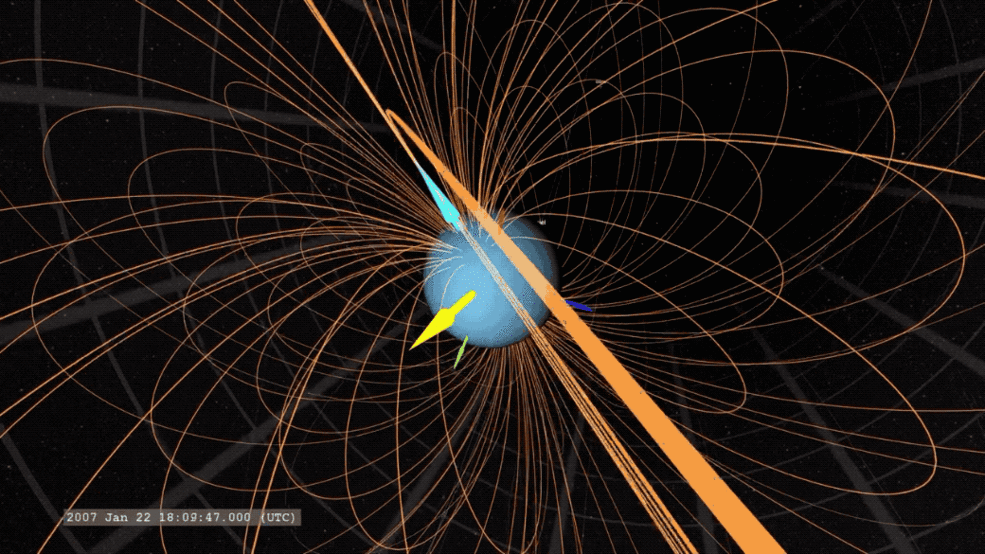By Miles Hatfield
NASA’s Goddard Space Flight Center
A new NASA study finds that our distant planetary neighbors, Uranus and Neptune, may have magnetic “seasons:” A time of the year when aurora glow brighter and atmospheric escape may quicken.
Study authors Dan Gershman and Gina DiBraccio, of NASA’s Goddard Space Flight Center in Greenbelt, Maryland, published the results in Geophysical Research Letters. Though these seasonal changes haven’t been directly observed, the results show that a combination of strong solar activity and Uranus’ and Neptune’s unusually tilted magnetic fields is likely to trigger them.
From Mercury to Neptune, every planet in our solar system feels the unceasing stream of the solar wind. This barrage of solar particles, traveling hundreds of miles a second, drags the Sun’s magnetic field out to space, inevitably colliding with planetary magnetic fields.
But each planet responds differently. For planets closer to the Sun, like Mercury and Earth, the solar wind can really shake things up. Strong blasts of solar wind create our northern lights – at their worst, they can even cause electrical surges that lead to blackouts. (Mercury is hit so hard that it can’t even sustain an atmosphere.)
On Jupiter and Saturn, the solar wind’s blast has little effect. This is not because they’re farther away from the Sun – the most important factor is their magnetic fields, which are optimally positioned to protect them. These planets have strong magnetic fields aligned almost perfectly vertically, like a spinning top. As the solar wind blows past Saturn, for instance, it hits its equator, meeting its magnetic shield where it is strongest.

Credits: NASA/Scientific Visualization Studio/Tom Bridgman
Uranus and Neptune are even farther away from that strong solar wind source, but their magnetic axes make them vulnerable. Uranus’ magnetic axis is tilted by a full 60 degrees. This means that for a portion of its 84-year-long trip around the Sun, the Sun shines almost directly into the planet’s magnetic north pole, where the planet is least protected. Neptune’s axis is similarly tilted – though only by 47 degrees.

Credits: NASA/Scientific Visualization Studio/Tom Bridgman
With that background knowledge, Gershman and DiBraccio set out to study how the solar wind would affect the ice giants. Using historical data from the Helios, Pioneer and Voyager spacecrafts, Gershman and DiBraccio measured the Sun’s magnetic field throughout the solar system.
The results showed that during intense conditions, the solar wind can be as impactful near Uranus and Neptune as it normally is near Mercury, some 1.5 billion miles closer to the Sun.
Such intense conditions aren’t even a rarity. The enhanced solar activity Gershman and DiBraccio studied occurs regularly, as part of the 11-year solar cycle. The solar cycle refers to the periodic flipping of the Sun’s magnetic field, in which activity rises and falls. At the high point, known as solar maximum, the Sun’s magnetic field throughout space can double in strength.
If the Sun enters solar maximum when Uranus or Neptune is at the appropriate angle, the effects, Gershman and DiBraccio argue, could be extreme. These planets so far from the Sun could suddenly be driven by it. Though the seasonal effects have not yet been directly observed, the physics suggests that aurora should brighten and spread further across the planet. Globs of particles known to escape the Uranian atmosphere may do so at a quickened pace. But only a few Earth-years later, it all goes away and the planets enter a new magnetic season.
The only close-up measurements we have of the planets are from the single flyby of Voyager 2 in 1986 and 1989, respectively. But a future NASA mission to the Ice Giants may well change that, giving us the first glimpse of their other-worldly magnetic seasons.

